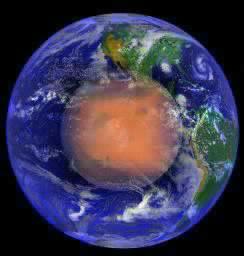
Cydonia Quest C D&M Pyramid - Examining the "Girders" C Part Four C
This page contains some very large images. Readers are advised to view this page in "full screen" mode to fit more of each image onto the screen at the same time. Press the F11 key to enter "full screen" and then F11 again to return to the normal browser view.
Some readers will also benefit by increasing their browser "zoom" by an increment - hold down the control key (Ctrl) and press the plus key (+). To return to standard zoom hold down the control key and press the minus key (-). For tips about adjusting the appearance of your browser display click here.
Viewing the images in low lighting conditions also makes details easier to see.
C The D&M Pyramid's eastern facet
The prevailing winds in Cydonia blow mostly from the west. Therefore, the eastern facet of the D&M Pyramid is better protected from scouring wind erosion that would otherwise carry its surface away as dust. One result of this is that eons of crumbling rubble has remained to coat this facet's surface as an obscuring layer. Images 1 and 2 in the illustration below give a good impression of this downward flowing blanket of rubble and dust. (Images 1 to 4 zoom in closer on part of the D&M).
However, there are places were the rubble blanket has been disturbed and something more structural looking pokes into view. At first glance the area highlighted in red in Image 2 appears to be a partial landslide. Closer examination (in images 3 and 4) reveals a less chaotic surface than a landslide, and something much more like an artificial and ruined structure. The surface in Image 4 is similar to the twisted remains of a conventual grid of four sided architectural cells. The scene in Image 4 is about 620 feet in width, so the walled cells in the grid would originally have been the size of buildings.
The reason why the grid in this area became exposed appears to be due to a chunk of the D&M shifting slightly forwards and also vertically downwards. The forward direction of shift is revealed by the bulldozing up of a "crumple zone". If the D&M really is a constructed arcology, then this partial collapse would have caused the overlying rubble to flow into the Pyramid's interior spaces. This subsidence of the rubble blanket would have left behind the structural matrix of the D&M exposed to the elements.
(This article continues below the illustration poster).
The next illustration poster examines another part of the eastern facet of the D&M where a landslide of the rubble blanket seems to have left the underlying surface "naked". Even though the exposed area is highly and differentially eroded, it is relatively easy to make out a dense grid of four sided cells/boxes. These residual boxes are on the scale of rooms - so are smaller than in the previous example. (The last image is zoomed-in so that it has a width of about 300 feet).
In the context of the artificial arcology hypothesis there are two ways of viewing these apparently ruined grids. The first is that the grids are actually the remains of rooms and other residential areas within an ancient D&M arcology. We can get a feeling for this possibility from the following illustration. It shows a massive residential complex in Aleppo that has suffered accelerated erosion resulting from criminal inhumanity.
The effects of this artillery erosion are uneven. In some places a blanket of rubble hides the undamaged rooms that are deeper inside the complex. This is the same effect being proposed for a large part of the eastern facet of the D&M Pyramid that is covered with rubble. It could therefore be the case that as we dug deeper inside the D&M we too might also encounter undamaged rooms that are empty of rubble and dust.
Many of the possible arcologies at Cydonia appear to have been protected by a thick outer shell. They are rather limpet-like in this regard. If this is also true for the D&M Pyramid then a second way of viewing the grids on the eastern facet is that they are the embedded reinforcing exposed as this shell erodes away. The images of the construction of the Hoover Dam (below) illustrate this proposal. In order to get such colossal amounts of cement to set the dam builders first built reinforced boxes into which they poured the wet concrete. If we were to time travel to the Hoover Dam's very distant future we might find that the reinforced boxes eroded more slowly than the concrete filler. As a result the boxes would stand out from the dam's eroding surface as a raised grid pattern - just as we see on the surface of the D&M Pyramid.
If the D&M actually is an artificial shelled arcology, could this shell have resisted millions of years of gravity and avoided sagging down to crush the D&M's architectural spaces? It would be extremely exciting if the D&M Pyramid still had a vast interior that astronauts could explore. The image below shows how architectural grids can span huge distances with little under-support. What is even more impressive about Seville's Metropol Parasol is that it is made out of wood.
Click the links below to continue reading this article.
µ Back to Part 1 µ Back to Part 2 µ Back to Part 3 µ Forward to Part 5 µ Back to the Mars Page µ Back to Cydonia Quest Main Page C
|




